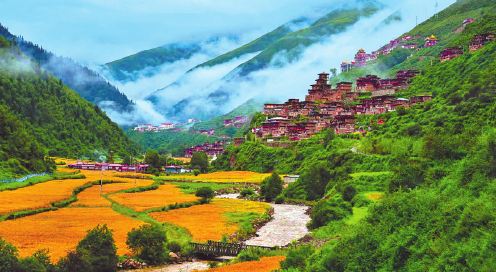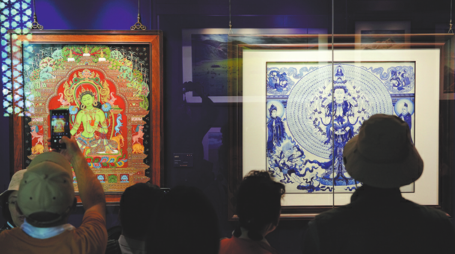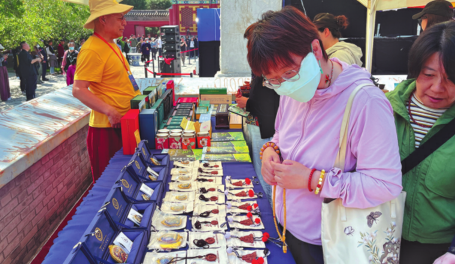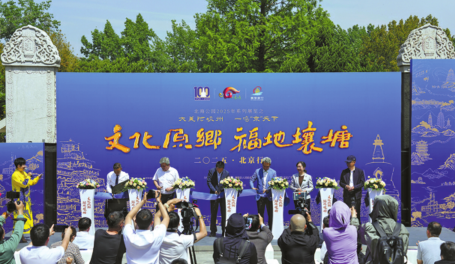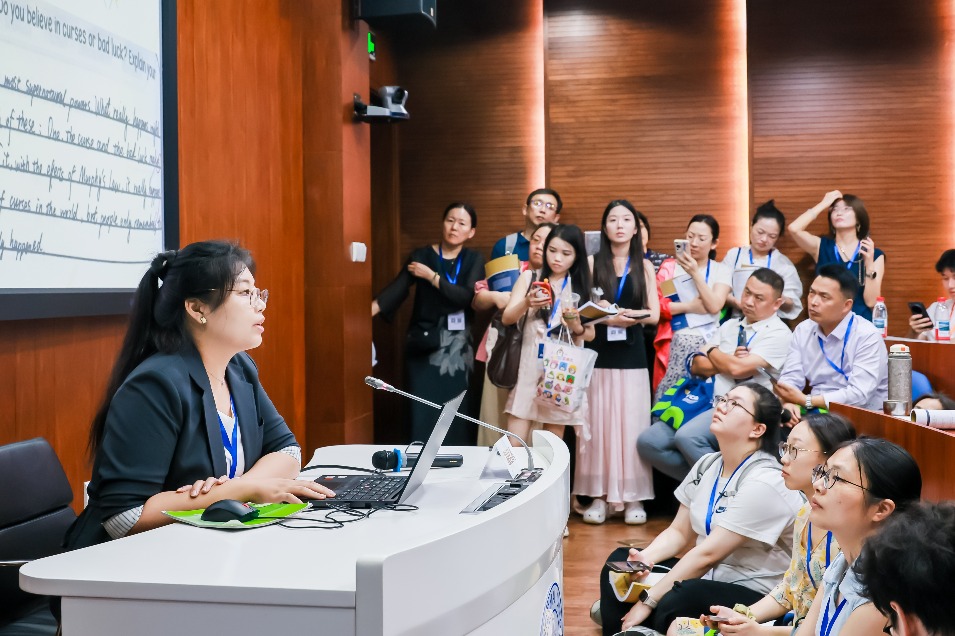Tibetan crafts entice city shoppers
Exhibition of cultural heritage, old and new, once again draws crowds to Beijing's Beihai Park, Yang Feiyue reports.

Chodzin has been surrounded by eager visitors inquiring after his work ever since he set up his booth in Beijing in late April.
He makes tsatsa, intricate Tibetan clay sculptures, from three-dimensional Buddhist deities, stupas and mantras, to other sacred symbols.
"They were all handmade by myself and my students and are a manifestation of traditional Tibetan tsatsa, which has deep spiritual and cultural roots," says the man from Rangtang county, in the west of the Aba Tibetan and Qiang autonomous prefecture, Sichuan province.
Each piece reflects the creativity of its maker, he says.
Rooted in Tibetan Buddhist practices, tsatsas are primarily made as merit-making offerings. They are commonly placed in stupas, on altars, or at holy sites as acts of devotion, and are believed to bring blessings and protection.
The sculptures are not only exemplary for their round forms but also for their use of a variety of techniques, including bas-relief, line engraving, and painting, Chodzin explains.
"The diversity of sculptural methods and molding techniques results in a wide array of poses and forms, giving each tsatsa its own unique expression," he says.
He and his apprentices have injected fresh vitality into the art form by applying it to decorative and functional items, such as pendants and car hangings.
"The materials remain rooted in tradition — highland clay and bright mineral pigments," he says.
The tsatsa works are among 500 handicrafts and cultural products on display at the second edition of Cultural Homeland, Blessed Rangtang, a cultural and tourism promotion event that will last until June 3 at Beijing's Beihai Park. The event coincides with the 100th anniversary of the park being opened to the public.
Rangtang county is a proud custodian of Tibetan cultural heritage, with an impressive ecosystem of intangible cultural preservation that covers 122 protected heritage items, 175 master artisans, 69 dedicated training centers, and 15 specialized craft workshops, the county's deputy Party secretary Ngawang explained at the event launch ceremony, which was hosted by Rangtang government, BTG Tourism Development and Beihai Park.
"The intangible cultural skills of Rangtang are cultural codes carved by the hands of artisans. From the precision of thangka paintings to the intricate patterns of handweaving, from the grandeur of stone carving to the sacred movements of Tibetan opera, each tradition embodies the collective memory and spiritual devotion of Rangtang's people," Ngawang says.
The ongoing exhibition showcases a carefully curated selection of cultural innovations, with everyday objects transformed into carriers of tradition, such as elegant accessories glowing with thangka-inspired pigments, and stylish bags woven with reinvented Tibetan motifs.
"Through these cultural creations, we hope to share Rangtang's heritage and invite the world to experience the beauty of intangible cultural craftsmanship," he says.
Apart from the tsatsa, fellow exhibitor Tsering Gyel's fusion of traditional Tibetan thangka painting with the art of ceramic has also caught visitors' attention.
The man in his 30s has painted representations of two prominent Buddhist figures on ceramic plates, both depicted in the soft hues of pastel colors.
"In every stroke, I seek to honor the essence of what these figures represent — wisdom, compassion and purity," Tsering Gyel says.
In a bold departure from tradition, he has combined the time-honored techniques of thangka painting with the elegance of porcelain, an idea he began to explore about five years ago.
He says that the fusion of these two mediums allows him to infuse the sacred geometry and symbolism of the thangka with the organic fluidity and tactile nature of ceramics.
"When I paint on ceramics, it feels like I'm bringing life to the figures, giving them a new dimension. Ceramics have a certain warmth and glow that the traditional thangka doesn't always capture. The material feels like a canvas that can reflect both light and shadow — like life itself," he adds.
The inspiration for this shift came after Tsering Gyel had been honing his thangka painting skills for over 15 years.
With the support of a training facility in Rangtang, he ventured into ceramic art in Jingdezhen, a city renowned for its porcelain craftsmanship.
"The ceramics have a depth and resonance that I've always admired. My hope is to take these two worlds — the Tibetan thangka and Chinese porcelain — and weave them together in a way that feels both timeless and contemporary."
His approach to ceramics involves applying mineral pigments in layers, a technique that echoes traditional thangka painting, but which is adapted to the particular properties of porcelain.
Tsering Gyel emphasizes that it's important to carefully mix colors to ensure they complement the porcelain's natural glow, resulting in an effect that is both luminous and deep.
This commitment to preserving and advancing Tibetan art has earned him and his peers in the trade recognition both in China and abroad.
"Our work has been presented as state gifts to senior officials from Portugal, and has been bought by museums," he says with pride.
Wang Zhen, general manager of the event's co-host, BTG Tourism Development, believes the second edition will further endear Rangtang county to capital residents.
"Last year's response was extraordinary," Wang says of the effect of the first exhibition in March 2024.
"The event lasted for 20 days, and we welcomed close to 120,000 visits. The scale of participation spoke for itself," he adds.
Wang considers the event more than a showcase, and more as a cultural bridge between Beijing and Rangtang.
"Inspired by what they saw, many people went on to visit the region in person, tracing the origins of its art, spirituality, and landscape," he says.
The impact extended well beyond tourism.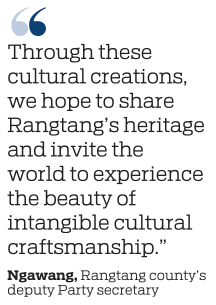
"We saw experts from institutions like the China Tourism Academy express genuine interest," Wang says. "They offered support, ideas, and resources, contributing to the upgrading of Rangtang's cultural and tourism in a tangible way."
So far, the tourism development company has designed a series of tailored travel experiences, ranging from cultural immersion and Tibetan cuisine tours, to landscape photography journeys.
The broader plan includes aligning Rangtang's tourism development with the provincial strategies set by Sichuan, to ensure that new tourist offerings are rooted in feasibility and sustainable growth, Wang says.
For Chodzin, the popularity of these creative cultural products has brought tangible benefit to his community.
His tsatsa workshop, part of a network of more than 40 cultural heritage centers in Aba prefecture, employs around 20 artists, including local craftsmen who shape the clay, and skilled painters from a nearby thangka school.
In recent years, invitations have poured in, and Chodzin has demonstrated his hometown's appeal at major events, including the Western China International Fair, and various national craft exhibitions, where city collectors marveled at the tiny clay deities.
Sales have been promising. One of their most successful events in Wenzhou in Zhejiang province last year netted over 100,000 yuan ($13,750).
"Many of these artisans had no prior experience of making art for the market, but through the workshop, they have gained both economic opportunities and a renewed connection to local cultural heritage," he says.
